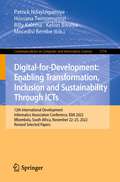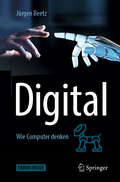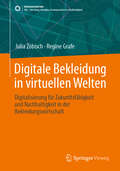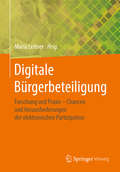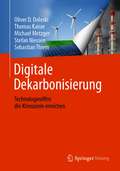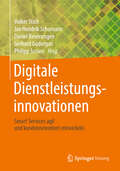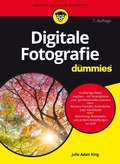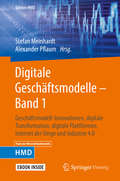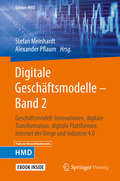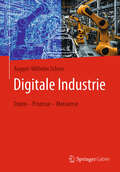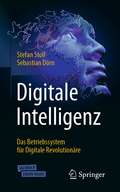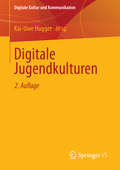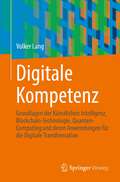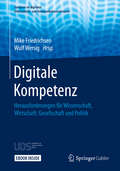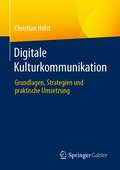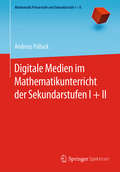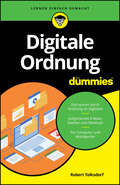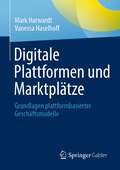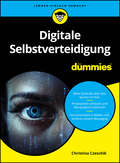- Table View
- List View
Digital-for-Development: 12th International Development Informatics Association Conference, IDIA 2022, Mbombela, South Africa, November 22–25, 2022, Revised Selected Papers (Communications in Computer and Information Science #1774)
by Patrick Ndayizigamiye Hossana Twinomurinzi Billy Kalema Kelvin Bwalya Mncedisi BembeThis book constitutes the refereed proceedings of the 12th International Development Informatics Association Conference, IDIA 2022, held in Mbombela, South Africa, in November 2022. The 20 revised full papers presented in this volume were carefully reviewed and selected from 61 submissions. The papers are organized in topical sections on theories and practices in digital-for-development ecosystems; emerging technologies for transformation, inclusion and sustainable development; privacy and security in digital-for-development ecosystems; human-computer interaction (HCI) for digital inclusion; artificial intelligence (AI) for good.
Digital: New Scenarios for Organizing (Lecture Notes in Information Systems and Organisation #72)
by Francesca Ricciardi Alessio Maria Braccini Francesco ViriliThis book presents a collection of research papers that aim to elucidate the pivotal role of digital systems in driving the formation and evolution of digital ecosystems, thereby shaping new scenarios for organizing in the digital age, by considering people practices, organizational processes, and system design issues. Each chapter offers insights into the ways in which digital systems and digital ecosystems contribute to addressing societal challenges, promoting sustainable development, enhancing collaboration and mitigating the negative effects of technological disruption. Using a multidisciplinary perspective and multimethodological approaches, it explores the impact of digital (eco)systems on governance structures, economic models and social dynamics and provides insights into the transformative potential of digitalization in shaping the future of societies worldwide. The diversity of perspectives makes this book particularly relevant for academics, businesses and public sector organizations. The content of the book is based on the revised versions of a selection of the best papers presented at the annual conference of the Italian Section of the AIS in October 2023 in Turin, Italy.
Digital: Wie Computer denken
by Jürgen Beetz„Mehr ist anders“, sagte ein Nobelpreisträger und meinte damit das Phänomen der „Emergenz“ — dass bei einer Zunahme von Quantität eine neue Qualität, etwas grundsätzlich Neues entstehen kann.Genau dies führt der Autor am Thema „Digitalisierung“ vor: Der Computer, der nach einfachsten technischen Prinzipien funktioniert, wird zum mächtigen Werkzeug, ja „Denkzeug“. Milliarden Computer, miteinander vernetzt, schaffen erneut einen Qualitätssprung: die Entstehung eines weltweiten Informations-, aber auch Überwachungsnetzes. Und wir erleben eine technische Revolution, die vor allem durch die „Künstliche Intelligenz“ ausgelöst wird. Diese Entwicklung wird in einfacher Sprache und mit vielen konkreten Beispielen in diesem Buch verständlich dargestellt. Ausgehend von der technischen Funktionsweise klassischer Computer sowie neuronaler Netze wird die Modellierung der Wirklichkeit in Form von Daten und Prozessen beschrieben. Aufbauend auf diesem Verständnis wird ein Teil der mannigfaltigen Aspekte der digitalen Vernetzung anschaulich geschildert und bewertet. So lernen die Leser, wie Computer „denken“. Letztendlich geht es um die Frage, ob die Digitalisierung Segen oder Fluch der Menschheit sein wird. Die Antwort des Autors wird Sie überraschen.
Digitale Bekleidung in virtuellen Welten: Digitalisierung für Zukunftsfähigkeit und Nachhaltigkeit in der Bekleidungswirtschaft (SDG - Forschung, Konzepte, Lösungsansätze zur Nachhaltigkeit)
by Regine Grafe Julia ZöbischDie Nutzung von digitaler Bekleidung als Verkaufsgut bietet eine Chance für effizienzbasierte Veränderungen in der Bekleidungstechnik, da insbesondere zeit- und materialintensive Prozesse entfallen bzw. deutlich reduziert werden können. Außerdem generiert die Transformation vom physischen zum digitalen Modedesign zusätzliche Marktsegmente und kann damit gleichzeitig das wirtschaftliche Innovationspotenzial der Branche erweitern. Der Bedarf an digitaler Bekleidung wird zu neuen Innovationen auf dem Gebiet der Software-Entwicklung führen, neue technische Schnittmengen, z. B. zur Gaming-Branche, generieren und damit gleichzeitig ein neues Feld auf dem Arbeitsmarkt für Einsteiger aus der Gaming-Branche schaffen.Dieses Buch präsentiert die Trends, die es derzeit in Sachen virtueller Bekleidung und den dafür sich entwickelnden Markt gibt. Ausgehend von der konventionellen Produktentwicklung in der Bekleidungstechnik und der digitalen Unterstützung durch 2D- sowie 3D-Design-Entwicklung soll aufgezeigt werden, welche produktionstechnischen Transfermöglichkeiten sich aktuell auf dem Markt für Bekleidung abzeichnen.
Digitale Bürgerbeteiligung: Forschung und Praxis – Chancen und Herausforderungen der elektronischen Partizipation
by Maria LeitnerBürgerbeteiligung, d. h. die Beteiligung der Bürgerinnen und Bürger an politischen Planungsprozessen oder Entscheidungen, wird bereits in Deutschland, Österreich und der Schweiz gefördert und gelebt. In Zeiten der Digitalisierung werden immer häufiger technische Applikationen zur elektronischen Partizipation (E-Partizipation) eingesetzt. Die Nutzung von Technologien bietet Chancen und Herausforderungen gleichermaßen, so zum Beispiel in den Bereichen Sicherheit, Datenschutz und nutzerorientierte Gestaltung. Das Buch greift genau diese Themen im Bereich der E-Partizipation auf und erläutert insbesondere Gestaltungsaspekte der digitalen Bürgerbeteiligung. Es kombiniert aktuelle Forschungsergebnisse mit bestehenden Theorien der E-Partizipation und bietet eine umfassende, interdisziplinäre Analyse aus sozialwissenschaftlicher, rechtlicher und technologischer Perspektive. Schutz der Privatsphäre und Sicherheit sind dabei zentrale Aspekte des Buches, die langfristig das Vertrauen in digitale Bürgerbeteiligung fördern können.
Digitale Dekarbonisierung: Technologieoffen die Klimaziele erreichen
by Thomas Kaiser Oliver D. Doleski Michael Metzger Stefan Niessen Sebastian ThiemDas Buch liefert erstmals konkrete Antworten auf die Frage, wie datenbasierte Verfahren bei der Dekarbonisierung von Betriebsprozessen helfen können. Der Text beschränkt sich dabei nicht auf die üblichen Ansätze zur Reduzierung klimaschädlicher Treibhausgasemissionen wie bspw. dem Verzicht des Einsatzes fossiler Energieträger. Vielmehr wird in dem Text der pragmatische und vor allem technologieoffene Blick auf die Dekarbonisierung energieintensiver Prozesse oder Verfahren gelenkt und dem Leser ein datenanalytisches Modell zur Optimierung des Energiesystems, welches dann deutlich weniger Treibhausgase emittiert, vorgestellt.
Digitale Dienstleistungsinnovationen: Smart Services agil und kundenorientiert entwickeln
by Volker Stich Gerhard Gudergan Daniel Beverungen Jan Hendrik Schumann Philipp JussenDieser Herausgeberband stellt Grundlagen und unternehmensspezifische Anwendungsbeispiele digitaler Dienstleistungsinnovationen vor, die in 23 Verbundforschungsprojekten der BMBF-Förderlinie “Dienstleistungsinnovation durch Digitalisierung“ entwickelt worden sind. Zunächst werden neue Methoden für die Entwicklung digitaler, datenbasierter Dienstleistungen vermittelt und anhand von Umsetzungsbeispielen veranschaulicht. Dabei wird beispielsweise der Vergleich von klassischen Methoden des Service Engineerings mit neuen agilen Vorgehensweisen gezogen. Darauf aufbauend werden Potenziale digitaler und virtualisierter Dienstleistungsprozesse aufgezeigt. Darüber hinaus wird die unternehmensinterne Transformation durch digitale Dienstleistungen untersucht, indem übergeordnete Muster der Veränderungen betrachtet und Leitlinien für die erfolgreiche Transformation ausgearbeitet werden. Schließlich werden Veränderungen im Markt durch das zunehmende Angebot von digitalen Dienstleistungen beleuchtet und strategische Erfolgsfaktoren für die Digitalisierung der Kundenschnittstelle in Dienstleistungssystemen herausgearbeitet. Der Herausgeberband vermittelt Fachexperten und Entscheidungsträgern in Unternehmen somit neuestes Methodenwissen, erfolgreiche Anwendungsbeispiele sowie einen klaren Navigationsrahmen für die Einführung und das Management innovativer, digitaler Dienstleistungen.
Digitale Fotografie für Dummies (Für Dummies)
by Julie Adair KingOb Sie mit einer billigen Kompaktkamera, einer High-End-Kamera mit zahlreichen Extras, einem Smartphone oder einer Action-Cam fotografieren - mit ein paar einfachen Tricks können immer aus durchschnittlichen Fotos großartige Bilder werden. Digitale Fotografie für Dummies versorgt Sie mit genau diesen Tricks - und ein paar ausgefalleneren Ideen. Damit können Sie sich einen Fotokurs oder das Lesen der Gebrauchsanweisung Ihrer Kamera sparen. Finden Sie heraus, was die Kamera in Ihrer Hand kann und was sie nicht kann. Erlernen Sie einfache Techniken, die mit jedem Kameratyp funktionieren. Erfahren Sie das Geheimnis der richtigen Belichtung.
Digitale Führungskräfteentwicklung
by Martin A. Ciesielski Thomas SchutzDieser Band zeigt erstmals, wie Führungskräfte die notwendigen Kompetenzen entwickeln können, um im digitalen Wandel nicht nur bestehen, sondern diesen auch aktiv mitgestalten zu können. Anhand zahlreicher aktueller Praxisbeispiele aus Hochschulen, mittelständischen und Großunternehmen werden wirksame Methoden und Werkzeuge kurz und kompakt vorgestellt. Dabei fokussieren sich die Beiträge auf organisationale und technologische Voraussetzungen, HR-Maßnahmen sowie individuelle Haltungs- und Kulturfragen. Ein umfassendes Fachbuch, das veranschaulicht, wie professionelle Führungskräfteentwicklung der digitalen Unternehmenstransformation vor und nach dem Unternehmenseintritt konstruktiv und aktiv begegnen kann.
Digitale Geschäftsmodelle – Band 1: Geschäftsmodell-Innovationen, digitale Transformation, digitale Plattformen, Internet der Dinge und Industrie 4.0 (Edition HMD)
by Stefan Meinhardt Alexander PflaumDigitale Geschäftsmodelle und die damit verbundenen Änderungen stellen Unternehmen vor vielfältige Herausforderungen. Daher geht das zweibändige Herausgeberwerk zentralen Fragen nach: Wie kann die Transformation im Unternehmen hin zu digitalen Geschäftsmodellen erfolgreich gelingen? Wie müssen digitale Geschäftsmodelle in die Unternehmensstrategie eingebettet sein? Was bedeutet eine Transformation hin zu digitalen Geschäftsmodellen für die IT-Systeme und Prozesse im Unternehmen? Welche Chancen und Risiken gibt es bei Digitalisierungsprojekten? Wie sehen praktische Anwendungsszenarien für digitale Geschäftsmodelle aus und wie werden diese umgesetzt?Diesen Herausforderungen haben sich die Autoren aus Wissenschaft und Praxis des vorliegenden Werkes in der Fachbuchreihe Edition HMD facettenreich gewidmet. Sie liefern mit ihren Beiträgen entsprechende Antworten, gepaart mit Konzepten, Lösungsvorschlägen und Fallbeispielen aus der Praxis. Denn: Eine ganzheitliche Digitalstrategie eröffnet nicht nur Chancen für neue digitale Erlösquellen, sondern verfolgt in erster Linie die digitale Transformation des bisherigen Geschäfts.
Digitale Geschäftsmodelle – Band 2: Geschäftsmodell-Innovationen, digitale Transformation, digitale Plattformen, Internet der Dinge und Industrie 4.0 (Edition HMD)
by Stefan Meinhardt Alexander PflaumDigitale Geschäftsmodelle und die damit verbundenen Änderungen stellen Unternehmen vor vielfältige Herausforderungen. Daher geht das zweibändige Herausgeberwerk zentralen Fragen nach: Wie kann die Transformation im Unternehmen hin zu digitalen Geschäftsmodellen erfolgreich gelingen? Wie müssen digitale Geschäftsmodelle in die Unternehmensstrategie eingebettet sein? Was bedeutet eine Transformation hin zu digitalen Geschäftsmodellen für die IT-Systeme und Prozesse im Unternehmen? Welche Chancen und Risiken gibt es bei Digitalisierungsprojekten? Wie sehen praktische Anwendungsszenarien für digitale Geschäftsmodelle aus und wie werden diese umgesetzt?Diesen Herausforderungen haben sich die Autoren aus Wissenschaft und Praxis des vorliegenden Werkes in der Fachbuchreihe Edition HMD facettenreich gewidmet. Sie liefern mit ihren Beiträgen entsprechende Antworten, gepaart mit Konzepten, Lösungsvorschlägen und Fallbeispielen aus der Praxis. Denn: Eine ganzheitliche Digitalstrategie eröffnet nicht nur Chancen für neue digitale Erlösquellen, sondern verfolgt in erster Linie die digitale Transformation des bisherigen Geschäfts.
Digitale Identitäten und Nachweise: Lösungsansätze für vertrauenswürdige Interaktionen zwischen Menschen, Unternehmen und Verwaltung
by Jürgen Anke Michael Kubach Jan SürmeliDigitale Identitäten sind der Schlüssel zur digitalen Souveränität – für Personen, Unternehmen und den öffentlichen Sektor. Dieser Sammelband bündelt die zentralen Erkenntnisse des Forschungsprogramms „Sichere Digitale Identitäten&“ und bietet eine fundierte Basis für ein skalierbares, zukunftssicheres Identitätsmanagement. Im Fokus stehen selbstbestimmte Identitäten, mit denen Nutzende digitale Nachweise sicher in Wallets verwalten können und damit die Kontrolle über ihre digitale Identität zurückgewinnen. Diese Technologie bildet das Herzstück der neuen europäischen eIDAS-Verordnung von 2024 und wird den Umgang mit digitalen Identitäten grundlegend verändern. Anhand praxisnaher Anwendungsbeispiele aus Wirtschaft und Verwaltung zeigt der Band, wie sichere digitale Identitäten erfolgreich eingesetzt werden. Er beleuchtet aktuelle technologische Entwicklungen und innovative Lösungsansätze, die Nutzerfreundlichkeit und Sicherheit effektiv verbinden. Ergänzt wird dies durch methodische Ansätze zur Gestaltung von Identitätslösungen, eine Einordnung der rechtlichen Rahmenbedingungen und einen Ausblick auf die Potenziale übergreifender digitaler Ökosysteme. Dieses Buch ist ein unverzichtbarer Leitfaden für alle, die sichere digitale Identitäten für vertrauenswürdige Interaktionen erfolgreich etablieren und verwenden wollen. Dies ist ein Open-Access-Buch.
Digitale Industrie: Daten – Prozesse – Metaverse
by August-Wilhelm ScheerDaten sind der Rohstoff des digitalen Zeitalters. Doch erst die Kenntnis und Strukturierung des Datenschatzes entfaltet sein volles Potenzial zur Optimierung der Geschäftsprozesse. Industrieunternehmen verfügen in Logistik, Produktentwicklung und Fertigung über einen großen Datenschatz. Häufig ist dieser jedoch nicht integriert und digital aufbereitet. Das Buch zeigt, wie die Daten aufgedeckt, strukturiert und zur dringend notwendigen digitalen Transformation genutzt werden können. Dazu werden detaillierte Referenzmodelle für Daten und Geschäftsprozesse im Rahmen einer Enterprise Architecture entwickelt. Sie sind Voraussetzung zur Priorisierung von Digitalisierungsprojekten, zum Aufbau intelligenter Datenarchitekturen und zur Entwicklung eines übergreifenden Digitalisierungsplans. Gleichzeitig sind sie auch Grundlage für aktuelle Entwicklungen wie digitale Zwillinge und das Industrial Metaverse. Ein unverzichtbarer Kompass für Fach- und Führungskräfte sowie für Studierende und Lehrende in Wirtschaftsinformatik, Technik, Produktion und Betriebswirtschaft.
Digitale Intelligenz: Das Betriebssystem für Digitale Revolutionäre
by Sebastian Dörn Stefan StollDie Digitalisierung ist da. Sie ist aber noch längst nicht überall angekommen. In unseren Unternehmen dominieren noch die Strukturen und Denkkonzepte des Industriezeitalters. Auf individueller sowie gesellschaftlicher Ebene scheinen Digitale Innovationen jenen psychologischen Zustand auszulösen, den der Zukunftsforscher Alvin Tofler in den 1970er Jahren als Zukunftsschock bezeichnete. Die Überflutung mit Neuem sowie die allgegenwärtigen Mahnungen nach schneller Anpassung führen zu Überforderung, Ängsten und Ablehnung. Deutschland steht in einem immer schärferen, globalen Wettbewerb, der zunehmend über Software, Daten, Algorithmen und Künstliche Intelligenz geführt wird. Durch den Einsatz Digitaler Technologien lösen neue Geschäftsmodelle die Logik des traditionellen Geschäfts ab. Auf dieser zweiten Welle der Digitalisierung muss die deutsche Wirtschaft eine Antwort finden. Wie können Unternehmen im Zeitalter der Digitalen Transformation das eigene Geschäft sichern und langfristig überleben? Dieses Buch vermittelt Denk- und Handlungswerkzeuge, die die aktuellen Trends der Digitalisierung mit zeitlosen Grundsätzen untermauern. Der Leser erlangt dadurch eine Digitale Intelligenz, die Orientierung im Dschungel der Digitalisierung ermöglicht.
Digitale Jugendkulturen
by Kai-Uwe HuggerJugend ist gegenwärtig nicht nur Offline-Jugend, sondern zugleich Online-Jugend. Auch die in diesem Band im Mittelpunkt stehenden jugendkulturellen Vergemeinschaftungsformen, in deren Rahmen sich Jugendliche selbst darstellen, mit ihrer Identität auseinandersetzen und soziales Miteinander von Gleichgesinnten finden können - sei es HipHop, Gothic, Techno oder sei es neuerdings die Emo- oder Visual Kei-Szene -, sind heute nicht mehr denkbar ohne ihre Erweiterungen im Internet. Insofern sind Jugendkulturen immer auch digitale Jugendkulturen. Freilich nutzen nicht alle jugendkulturellen Gesellungen Internet, Computer und mobile Geräte (Handys, Smartphones, portable Spielkonsolen etc. ) in gleichem Maße. Was also sind die Kennzeichen digitaler Jugendkulturen? Zu welchen Zwecken werden überhaupt welche digitalen Medien in welchen Jugendkulturen benutzt? Und: Gibt es tatsächlich eine Cybergeneration?
Digitale Kompetenz: Grundlagen der Künstlichen Intelligenz, Blockchain-Technologie, Quanten-Computing und deren Anwendungen für die Digitale Transformation
by Volker LangWenn Sie neugierig auf die Grundlagen der künstlichen Intelligenz, der Blockchain-Technologie und des Quantencomputings sind, die für die digitale Transformation und Innovation von entscheidender Bedeutung sind, ist Digital Fluency Ihr praktischer Leitfaden. Die realen Anwendungen dieser Spitzentechnologien nehmen rapide zu, und Ihr tägliches Leben wird weiterhin von jeder dieser Technologien beeinflusst werden. Es gibt keinen besseren Zeitpunkt als jetzt, um anzufangen und sich digital fit zu machen.Sie müssen keine Vorkenntnisse über diese vielseitigen Technologien haben, denn der Autor Volker Lang führt Sie kompetent durch das digitale Zeitalter. In zahlreichen Praxisbeispielen und mehr als 48 einprägsamen Abbildungen veranschaulicht er in Digital Fluency zentrale Konzepte und Anwendungen. Am Ende jedes Kapitels finden Sie eine hilfreiche Checkliste zur Umsetzung der zentralen Lektionen, bevor Sie zum nächsten Kapitel übergehen. Dieses Buch geht den digitalen Schlagwörtern und Konzepten auf den Grund und sagt Ihnen, was sie wirklich bedeuten.Das Aufschlüsseln von Themen wie automatisiertes Fahren und intelligente Robotik mit künstlicher Intelligenz, Blockchain-basierte Kryptowährungen und Smart Contracts, Medikamentenentwicklung und Optimierung von Finanzinvestitionsportfolios durch Quantencomputing und vieles mehr ist unerlässlich, um für die Zukunft der Industrie gerüstet zu sein. Unabhängig davon, ob Ihre eigene digitale Transformation in Ihrem privaten oder öffentlichen Unternehmen, in Ihrem Studium oder in Ihrem Privathaushalt stattfindet, Digital Fluency erstellt einen konkreten digitalen Aktionsplan für alle Ihre Anforderungen an Technologie- und Innovationsstrategien.Was Sie lernen werden Sich im digitalen Zeitalter orientieren, ohne Vorkenntnisse über digitale Technologien und digitale Transformation zu benötigen Lernen Sie die beliebtesten aktuellen und zukünftigen Anwendungen von künstlicher Intelligenz, Blockchain-Technologie und Quantencomputing in einer Vielzahl von Branchen kennen, darunter das Gesundheitswesen, Finanzdienstleistungen und die Automobilindustrie Machen Sie sich mit den digitalen Innovationsmodellen von Amazon, Google, Microsoft, IBM und anderen weltweit führenden Unternehmen vertraut. Setzen Sie Ihre eigene digitale Transformation entlang der acht Kerndimensionen eines konkreten digitalen Aktionsplans erfolgreich um.Für wen dieses Buch bestimmt ist Vordenker, Führungskräfte und Industriestrategen, Management- und Strategieberater, Politiker und Entscheidungsträger, Unternehmer, Finanzanalysten, Investoren und Risikokapitalgeber, Studenten und Forscher sowie allgemeine Leser, die sich digital fit machen wollen.
Digitale Kompetenz: Herausforderungen für Wissenschaft, Wirtschaft, Gesellschaft und Politik (Synapsen im digitalen Informations- und Kommunikationsnetzwerk)
by Mike Friedrichsen Wulf WersigDieses Buch präsentiert Konzepte, Lösungsansätze und Visionen aus unterschiedlichen Perspektiven, um die digitale Kompetenz bei Mitarbeitern und Führungskräften zu fördern. Es gilt auf die sich verändernden und steigenden Anforderungen an die Fachkräfte und die neuen Berufsbilder, die zu einer wachsenden Flexibilisierung und Digitalisierung des Arbeitsmarktes führen, angemessen zu reagieren. Somit besteht dringender Handlungsbedarf bei der Aus- und Weiterbildung in Digitalthemen für Mitarbeiter und Führungskräfte.Die Autoren zeigen, dass durch die internationale Verflechtung im Rahmen der Globalisierung und den daraus resultierenden Wettbewerbsdruck das Vorhandensein von digitaler Kompetenz eine Kernvoraussetzung für eine zukunftsweisende Entwicklung ist. Digitale Kompetenzen versetzen Mitarbeiter von Wirtschaftsunternehmen, Behörden und Bildungseinrichtungen in die Lage, digitale Technologien anzuwenden und darüber hinaus die digitale Transformation von Geschäftsprozessen und institutionellen Abläufen mit voranzutreiben.Der Inhalt• Was bedeutet digitale Kompetenz und was wird konkret benötigt?• Worin unterscheidet sich digitale Kompetenz von dem Buzz-Word Medienkompetenz?• Welchen Stellenwert hat die digitale Kompetenz in Unternehmen, Behörden und Bildungseinrichtungen?• Welche politischen Maßnahmen sind erforderlich, um digitale Kompetenzen aufzubauen?• Welche digitalen Kompetenzen müssen durch das Bildungssystem geschaffen werden?• Welche Veränderungen im Bildungssystem sind erforderlich?• Welche Handlungsoptionen und Lösungskonzepte gibt es?
Digitale Kulturkommunikation: Grundlagen, Strategien und praktische Umsetzung
by Christian HolstDieses Buch gibt einen Überblick über die Chancen und Risiken der digitalen Kommunikation für Kultureinrichtungen. Im ersten Teil werden die Besonderheiten der digitalen Kommunikation gegenüber analoger Kommunikation erklärt. Der zweite Teil beschäftigt sich mit Strategien und Techniken der digitalen Kommunikation und diskutiert, welche der einschlägigen Konzepte in welcher Weise auch im Kulturbereich angewendet werden können. Der dritte Teil schließlich gibt einen Überblick über die aktuellen Anwendungsfelder und Tools der digitalen Kommunikation sowie deren Chancen und Risiken. Hierbei werden viele erfolgreiche Anwendungsbeispiele aus dem Kultursektor herangezogen.
Digitale Markenführung: Digital Branding in Zeiten divergierender Märkte
by Ralf T. Kreutzer Karsten KilianDieses Buch zeigt, wie die Digitalisierung die Markenführung verändert, beschleunigt und professionalisiert. Die Kundenerwartungen sind gestiegen, die Möglichkeiten eines Dialogs auf Augenhöhe auch. Den 4 Ks der Markenführung folgend gilt es, die eigene Marke kompetent, kohärent, konsistent und kontinuierlich zu präsentieren – und überzeugend in der On- und Offline-Welt zu inszenieren. Im Buch wird erläutert, wie die folgenden Handlungsfelder der Markenführung im digitalen Zeitalter konkret auszugestalten sind: Customer-Experience-Management Content-MarketingCustomer-Engagement-ManagementRating- und Review-Management Influencer-Marketing Voice-Marketing Zusätzlich heben die Autoren hervor, dass bei aller Begeisterung für eine digitale Markenführung die physische Markeninszenierung weiterhin wichtig bleibt. Nur eine holistische Markenführung – online und offline – erreicht und begeistert Kunden über alle Sinne. So können Kunden langfristig an die Marke gebunden werden. Zusatzmaterial erhalten Sie via App: Laden Sie die Springer Nature Flashcards-App kostenlos herunter und nutzen Sie als Printbuchkäufer exklusive Inhalte, um Ihr Wissen zu vertiefen.
Digitale Medien im Mathematikunterricht der Sekundarstufen I + II (Mathematik Primarstufe und Sekundarstufe I + II)
by Andreas PallackEin Blick in aktuelle Bildungsstandards und Lehrpläne zeigt: Die Nutzung digitaler Medien im Mathematikunterricht wird immer stärker eingefordert und geht heute weit über den Einsatz wissenschaftlicher Taschenrechner hinaus. Zukünftige Lehrerinnen und Lehrer müssen sich deswegen notwendig bereits im Rahmen ihrer Ausbildung mit digitalen Medien auseinandersetzen. Entsprechend wird hier ein Lehrwerk angeboten, das, orientiert an den Funktionalitäten digitaler Medien, Chancen und Risiken der Nutzung in mathematikpädagogischen Kontexten strukturiert darstellt. Zentrales Anliegen ist die Entwicklung von Medienkompetenz mit Blick auf das Lehren und Lernen im Fach Mathematik. Das Lehrwerk basiert auf erprobten und bewährten Veranstaltungen im Rahmen der Lehrerbildung.
Digitale Ordnung für Dummies (Für Dummies)
by Robert TolksdorfVereinfachen Sie Ihr digitales Leben Mit den Methoden in diesem Buch räumen Sie Ihr persönliches digitales Durcheinander auf. Lernen Sie mithilfe von festen Prinzipien, strukturiert mit Mails, Dateien und Ihrer Nutzeroberfläche umzugehen. Robert Tolksdorf zeigt Ihnen, wie Sie Ihre digitale Welt ordnen und sich damit viel Zeit für umständliche Suchvorgänge ersparen. Räumen Sie Ihre Arbeitsumgebung auf und arbeiten Sie fokussiert, statt sich in einem Fensterdurcheinander zu verlieren. Jenseits Ihrer Desktop-Rechner oder Notebooks mit Windows und MacOS vereinfachen Sie auch den Umgang mit Ihren Mobilgeräten. Sie erfahren Welche Ordnungsprinzipien Ihnen das Leben erleichtern Warum gute Ordnerstrukturen und -namen viel Zeit sparen können Wie Sie fokussiert und ungestört digital arbeiten
Digitale Plattformen im industriellen Mittelstand: Strategien, Methoden, Umsetzungsbeispiele (Intelligente Technische Systeme – Lösungen aus dem Spitzencluster it’s OWL)
by Christoph Plass Daniel Beverungen Roman Dumitrescu Arno KühnDieses Buch stellt neue Strategien, Methoden und Umsetzungsbeispiele vor, mit denen digitale Plattformen zur Realisierung erfolgreicher Geschäftsstrategien im industriellen Mittelstand eingesetzt werden. Digitale Plattformen sind Erfolgsgaranten für viele Weltmarktführer im Konsumgüterbereich. Aber auch der industrielle Mittelstand kann mit ihrer Hilfe neue Geschäftsfelder erschließen und Wettbewerbsvorteile realisieren. In diesem Band zeigen wir auf, warum sich produzierende Unternehmen schon heute in diesem Wettbewerbsumfeld positionieren müssen und welche strategischen Handlungsoptionen existieren. Ein strukturierter Transformationspfad zeigt, wie der industrielle Mittelstand über die Etablierung digitaler Dienstleistungen den Sprung in die Plattformökonomie schaffen kann. Innovative Methoden und Werkzeuge bieten konkrete Hilfestellung, um diesen Transformationsprozess strategisch zu planen und umzusetzen. Zwei ausgewählte Praxisbeispiele zeigen schließlich auf, wie der Einstieg in die Plattformökonomie erfolgreich gelingt.
Digitale Plattformen und Marktplätze: Grundlagen plattformbasierter Geschäftsmodelle
by Mark Harwardt Vanessa HaselhoffDas Buch gibt einen kompakten Überblick über digitale Plattformen und digitale Marktplätze als Spezialform plattformbasierter Geschäftsmodelle. Die Autoren erläutern zentrale Charakteristika und Funktionalitäten digitaler Plattformen und zeigen verschiedene Wege in die Plattformökonomie auf. Sie beschreiben dabei Herausforderungen und Risiken sowie Erfolgsfaktoren und Strategien. Schließlich werden Marktplätze als konkrete Ausprägung digitaler Plattformen näher vorgestellt. Ausgewählte Praktiker berichten von ihren Erfahrungen mit dem Aufbau von Marktplätzen und reflektieren kritisch Herausforderungen sowie Lösungsansätze.Das Buch fasst den aktuellen Forschungsstand zusammen, ergänzt ihn um praktische Anwendungen und Erfahrungen und liefert somit vor allem Praktikern eine fundierte Einführung in die Thematik.
Digitale Selbstverteidigung für Dummies (Für Dummies)
by Christina CzeschikDer schwarze Gürtel für das Netz Sie wollen Ihre Privatsphäre und Ihre digitale Identität schützen? Dabei hilft Ihnen dieses Buch. Christina Czeschik klärt Sie darüber auf, wo Sie welche Daten und Metadaten hinterlassen, und hilft Ihnen dann dabei, darüber die Kontrolle zu behalten und so digital selbstbestimmt zu sein. Konkret erklärt sie Ihnen, wie Sie den Schutz Ihrer Privatsphäre bei E-Mails, Chats, Videocalls, in sozialen Netzwerken, beim Einkaufen, Surfen und Streamen sicher stellen. Zudem wirft sie einen kritischen Blick auf Smartphones, Apps und zuletzt auch unsere eigenen Gewohnheiten rund um das Internet. Sie erfahren Was es mit dem Konzept der digitalen Souveränität auf sich hat Wie Sie PGP und S/MIME für E-Mail-Verschlüsselung und digitale Signatur nutzen Welche Einstellungen für bessere Privatsphäre Sie im Browser treffen können Wie Sie mit Tor (fast) anonym browsen können
Digitale Transformation des Marketings und Vertriebs in B2B-Unternehmen: Konzepte und Anwendungsbeispiele (essentials)
by Axel SteuernagelDie digitale Revolution verändert Marketing und Vertrieb in B2B-Unternehmen grundlegend. Dieses Buch behandelt die wesentlichen Trends und Technologien, von digitalem B2B-Marketing zum virtuellen, datengestützten Vertrieb. Es enthält konkrete Handlungsempfehlungen für die digitale Transformation von Marketing- und Vertriebseinheiten. Dabei zielt der Autor immer darauf ab, digitale Ansätze mit den Vorteilen des persönlichen Vertriebs zu verbinden. Durch seine Kompaktheit ermöglicht das Buch Marketing- und Vertriebsexperten, sich sehr schnell mit den wesentlichen Elementen der digitalen Zukunft vertraut zu machen und diese mit ihrem täglichen Handeln zu verbinden.
